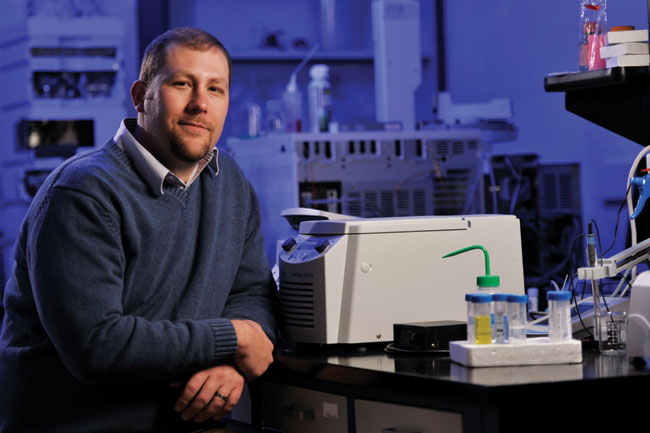
Some people may be overweight their whole lives and never suffer from nonalcoholic fatty liver disease’s most deadly effects – diabetes, cirrhosis, liver cancer and organ failure.
Jamey Young, assistant professor of chemical and biomolecular engineering, wants to learn more about the estimated 5-10 percent who do. If his research at Vanderbilt University School of Engineering can decipher metabolic differences in the livers of these individuals, the answer can lead to more effective treatment – or even blocking the disease from its start.
Up to a quarter of Americans suffer from nonalcoholic fatty liver disease. Since Young started his research at MIT 10 years ago, he’s learned he’s very close to two of them – his father and brother.
“Both of them had their gall bladders removed, and as a result of that surgery, a liver biopsy was done showing they already had it,” Young said. “There’s no FDA-approved treatment for fatty liver disease right now. The best current treatment is to lose weight and exercise more, the same as for other metabolic diseases.”
His team will try to inhibit the production of damaging free radicals in the liver to stop the progression of fatty liver disease in mice. That involves using medication commonly prescribed to treat a different disorder plus vitamins.
“I don’t think I could do this research anywhere else in the world. The culture here at Vanderbilt for being able to obtain NIH funding, cooperation from the medical center – it really is a one-of-a-kind situation.” — Jamey Young
People who are obese or diabetic carry high levels of fat in their blood, and the body deposits it in the liver. Metabolic differences determine whether that unhealthy situation leads to severe complications or not, Young said. Elevated liver enzymes in the blood are an early indicator of fatty liver disease, called steatohepatitis in its advanced stages.
Young and his team are coordinating with David Wasserman, director of Vanderbilt’s Mouse Metabolic Phenotyping Center, and Masakazu Shiota, associate professor of molecular physiology and biophysics. Previous work developing methods of measuring metabolic rates in mice led to Young’s hypothesis for his newest research: Mitochondrial metabolism is overactivated by the presence of fat in the liver, and that leads to the production of free radicals and compounds that damage to the liver.
The journal American Journal of Physiology-Endocrinology and Metabolism recently accepted a paper on the measurement methodology by Young, Wasserman and four other co-authors.
This project represents the first major research that will use the new methodology, Young said.
“I don’t think I could do this research anywhere else in the world,” he said. “The culture here at Vanderbilt for being able to obtain NIH funding, cooperation from the medical center – it really is a one-of-a-kind situation.”
Young’s research is being funded with a $1.7 million, 5-year RO1 grant from the National Institutes of Health. Young’s promotion to associate professor with tenure will be effective Aug. 1.
Contact
Heidi Hall, (615) 322-6614
Heidi.Hall@Vanderbilt.edu
On Twitter @VUEngineering